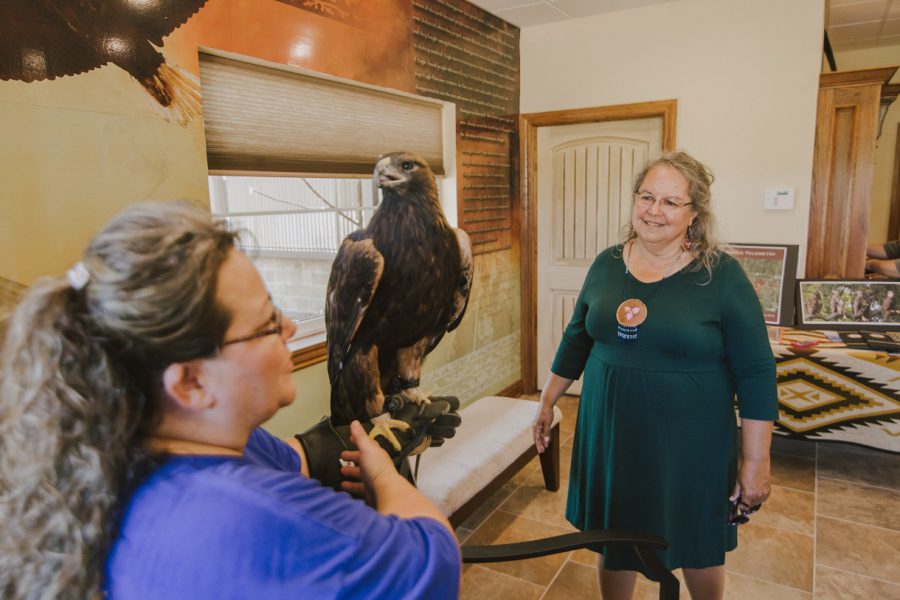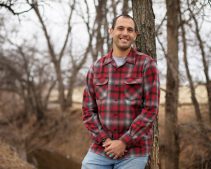
Dr. Robin Wall Kimmerer is an author and a professor of Environmental and Forest Biology at the State University of New York College of Environmental Science and Forestry (SUNY-ESF).
She also leads a new graduate studies program, “and it’s a mouthful,” Kimmerer said, then laughed. It is Sowing Synergy: A Graduate Program to Integrate Indigenous & Scientific Knowledge for Sustainability and Biocultural Restoration.
Now in its first year, Kimmerer connected with another Citizen Potawatomi Nation tribal member, Kaya DeerInWater, who is one of the first five students to join.
“It’s just so remarkable to me to be able to have this CPN team of botanists, this multigenerational education experience, from Kaya to me to the people who taught me,” Kimmerer said. “I’m not sure I believe in coincidences anymore — we had a brand-new graduate program about to form to do exactly the kind of work that Kaya was interested in.”
The inherently Indigenous concept of reciprocal restoration was nearly nonexistent as she earned her doctorate and began teaching 35 years ago. It combines scientific and empirical, or long-term cultural and spiritual, consideration, in efforts to restore and conserve land, communities and people’s relationships with the land.
“I related very much to Kaya’s partnership in our work together,” she said. “When I started out as an undergraduate all those years ago, there was no acknowledgment or room for Indigenous thinking in the realm of environmental science.”
While earning his graduate degree at SUNY-ESF, DeerInWater works with her toward that goal.
“Being the botanist I am, I’m really interested in our traditional plants and how we use our traditional plants for food, for arts and crafts, for medicine, for construction — all the different ways,” he said. “We all need plants, and, in our culture, they are our oldest teachers. They were here first, so they are our elders and they have lots of lessons to teach us.
“What really strikes me is that, if we have adapted over the years, then how have we adapted?”
It’s a concept Kimmerer is eager to explore with him. She considers herself a researcher as much as an educator, although teaching wasn’t something she planned to do.
“My initial intention was always to care for the plant world, plant conservation,” she said. “What I realized is that I could have a bigger impact on plant conservation by teaching it to, gosh, 35 years’ worth of students.
“I realized that it was an important responsibility. In return for education that I had received in botany and, in return for my great love of plants, I had to share that with other people so that they’d love them, too,” she added. “And when we love something, we take care of it. I guess that’s really my motivation.”
She said writing is an extension of that drive. Her most recent book, published in 2013, Braiding Sweetgrass: Indigenous Wisdom, Scientific Knowledge and the Teaching of Plants, earned the Sigurd F. Olson Nature Writing Award. The Guardian selected it as one of the best nature books of 2014.
She’s taking a teaching sabbatical next year and hopes to finish a follow-up to Braiding Sweetgrass.
“I’m working on another volume related to trying to understand plants as our elders, as our gifts,” Kimmerer said. “What are the gifts that plants provide for us, and how do we return that gift?”
She shared her thoughts on what she calls reciprocal restoration and the rights of nature movement, or plant sovereignty.

Hownikan: What’s the primary focus of your work with Kaya?
Kimmerer: Kaya’s project is that, of course when we think about restoring land, we will restore it to what condition? Who should be there and what should be there?
Kaya’s project is really to try to document and unearth — what was our traditional relationship with the plants? All over the world, we know that our plant knowledge — which our grandparents had abundantly — is disappearing.
Our goal — his goal — is to document and uncover plant knowledge that our people have and to protect that knowledge and to share it so that it once again becomes widespread in the community.
Hownikan: You speak of the importance of fostering a two-way relationship with nature, of reciprocity.
Kimmerer: The spirit of reciprocity is something that interests both Kaya and I greatly: How do we take care of the plants that take care of us?
One of the things that fascinates me is to think about our ancestors, who came to Oklahoma from the Great Lakes. The plants were pretty different between the Great Lakes forests and prairie. What were the plants that our ancestors relied on?
I also think a lot about the pecans and how the pecan trees took care of our people when we first arrived here. Well, how should we be taking care of the pecan groves today?
Hownikan: Why is that important?
Kimmerer: We talk a lot about sovereignty and self-determination, right? This is about a kind of intellectual self-determination for the land; to be able to think about the land through the lens of our cultural values.
Rather than this notion that land is property and land is natural resources and land is capital, let’s go back to our traditional philosophy that land is our responsibility. The land is the source of our identity, the land is our pharmacy, the land is our library.
I think that it’s part of the broader cultural revitalization movement of healing land and healing culture at the same time.
Hownikan: What is your Potawatomi family lineage?
Kimmerer: Vieux and Johnson.
Hownikan: You’ve specifically mentioned the importance of Potawatomi teachings. Will you explain that a little more in relation to biocultural restoration?
Kimmerer: Our Potawatomi culture, as well as many cultures, are based in gratitude — gratitude for the gifts that the living world provides for us. Reciprocity then says, “Well, what are the gifts that we human beings can give back to the land in return for everything that the land gives us of water and food and companionship and identity?” and our relatives who live there, everything. …
When I talk about this in terms of a cultural setting, I think of it very much in the vein of the teachings of the Seven Fires prophecies. They tell us that the job of Seventh Fire people is to go back along the ancestors’ road and pick up that which was left for us so that all life could thrive.
I think the work of restoration and, in particular, biocultural restoration — that healing land and culture at the same time — is our responsibility as Seventh Fire people.
To us, plants have long been recognized as our elders, as our teachers. We need to remember that again.
Hownikan: So, this is a concept that’s been around for a long time?
Kimmerer: It is focused on bringing together both traditional knowledge and scientific, ecological knowledge. So, there’s that theme of using both ways of knowing to take care of land, but it’s really a new paradigm. …
So many of our communities have had damage to our traditional lands and ecosystems from development, from colonialism, etc. We need to think about the ways that we can simultaneously heal the land while healing our relationship to land using some of the tools and approaches of traditional ecological knowledge.
We’re talking about healing land in our communities, restoring those places to cultural use and restoring many of our plant and animal species that have been lost through development and through, again, the process of colonization.
Hownikan: In that vein, what is something you hope grows out of Kaya’s project?
Kimmerer: I imagine the Tribe owning a large piece of land dedicated to restoration of plant knowledge.
Wouldn’t that be awesome? It could be a park or an educational piece of land. People could go and learn the plants again, learn about our traditional use of something and all these things we’ve been talking about: What are the teachings that the plants offer us and how do we be better students to meet that?
The next step is to do this restoration work on the land and make a place where people can go back again, learn the plants and refresh and remember our relationship to them. It’s a way to care for the people and it’s a way to care for the plants.
Because all of this knowledge is not ours — the knowledge of our ancestors is knowledge of the land itself. Our job is to protect, honor and respect that knowledge.
Hownikan: How has the study of botany changed since you were in school?
Kimmerer: We’ve gone from invisibility when I began to an embrace of traditional knowledge as a really important partner to science and in caring for Mother Earth.
It was invisible, less than invisible if there is such a thing. Today, to say that we have the Center for Native Peoples and the Environment; that we have a whole curriculum that incorporates indigenous ways of knowing as a partner to science; and that we can have a graduate program where wonderful, brilliant young Native students can come to study environmental science and bring their traditional values and knowledge into that endeavor.
I would say that that’s one of the things I would say I’m proudest of and it’s embodied in Kaya, in this next generation. That we have a place where a Potawatomi professor and a Potawatomi student can come together and use our own traditional teachings to care for plants.
That’s a dream come true for me.
Hownikan: What’s next? Is another book in the works?
Kimmerer: I am. I’m on sabbatical next year, so hopefully, I’ll be able to have that whole time to finish it and bring it into reality.
I’m also super interested in — actually it’s an issue that is really prominent in Oklahoma. This idea of plants — and this new book will hopefully develop this idea further — is that in our traditional understanding of plants as our relatives, as our elders, as our teachers. …
The notion that that land has a right to be.
